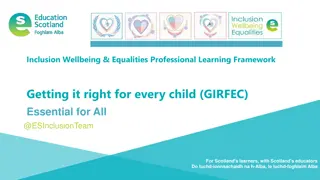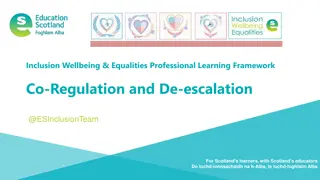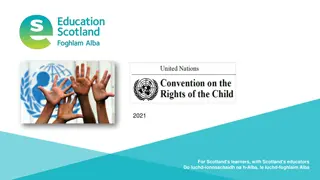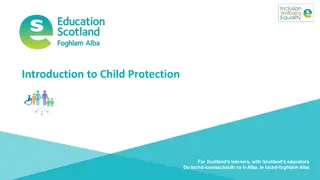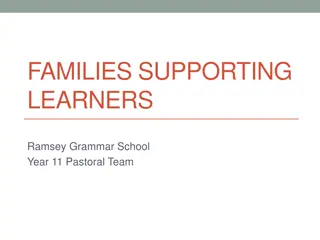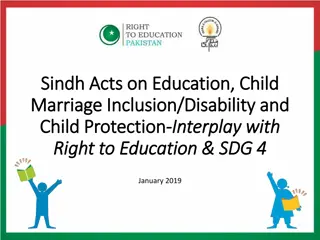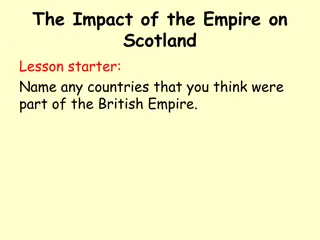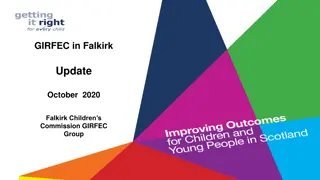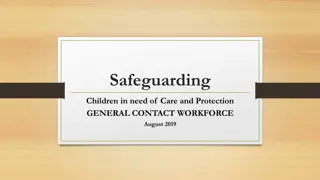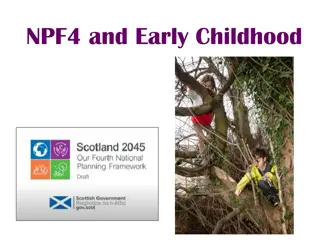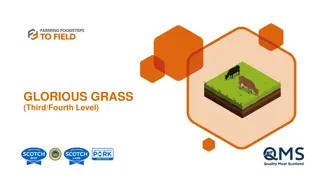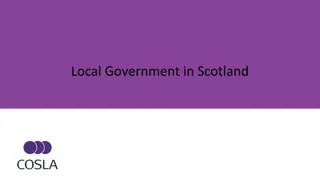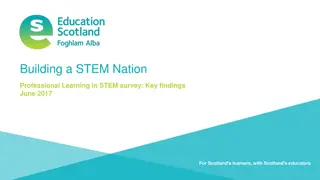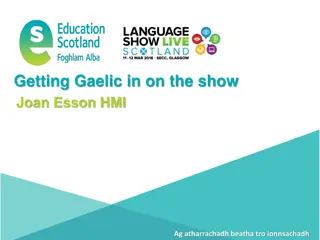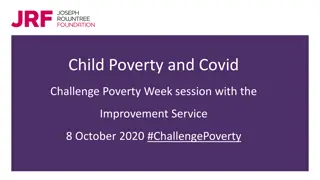The Importance of Getting it Right for Every Child in Scotland
Understanding the GIRFEC approach is essential for protecting and supporting Scotland's children by focusing on assessing, planning, and analyzing information to help every child reach their potential. GIRFEC emphasizes collaboration between agencies, timely support, and a child-centered approach to achieve positive outcomes for all children, not just those in need.
Download Presentation

Please find below an Image/Link to download the presentation.
The content on the website is provided AS IS for your information and personal use only. It may not be sold, licensed, or shared on other websites without obtaining consent from the author. Download presentation by click this link. If you encounter any issues during the download, it is possible that the publisher has removed the file from their server.
E N D
Presentation Transcript
- The evidence base for protecting and supporting Scotland s children - Getting it right for every child Jane Aldgate OBE Professor of Social Care The Open University
What is Getting it right for every child? A national programme of assessing, analysing information and planning for children Getting it right for every child starts in the universal services of health and education Getting it right for every child recognises the part families and everyone working with children plays in helping children reaching their potential Additional help should be proportionate and timely built from the support every child should get automatically from health and education Children and young people are at the centre of all activity about them and their lives Getting it right for every child expect agencies to work together to help all children and young people grow, develop and reach their full potential
GIRFEC is about all children GIRFEC is about all children not just children in need , not just those looked after , and not just those at risk or with the most acute or complex needs. It should not matter how a child s needs come to light or how they are categorised (child protection, offending, young carers, LAC) . What matters is that help is provided where necessary integrated between agencies - and that outcomes are improved Change needs to take place on three fronts: culture, systems and practice to help practitioners align services to enable children and young people to grow, develop and reach their full potential.
Why do we need GIRFEC? Children fall though gaps Children get passed from one agency to another Services screen out kids Agencies don t share information Processes are duplicated
Key practitioners within GIRFEC Each child will have a named person in the universal services of health or education who will trigger additional help There will be a lead professional where two or more agencies are working together
Characteristics of GIRFEC practitioners: approachable and helpful Children and families should feel confident that: they can rely on appropriate help being available as soon as possible the agency they first have contact with will arrange for help to be provided, not pass them on elsewhere meetings will be child and family friendly and arranged to suit them their worries and views have been listened to carefully and their wishes have been heard and understood
A child and family friendly service Practitioners will ensure that parents and children participate at every stage by: fully involving them in discussions and making sure they understand what is happening at every stage; asking their opinions and seeking their consents; planning meetings, where they are necessary, at times convenient for children and families; sharing information with them; constructing plans with them.
Four questions for practitioners What is getting in the way of this child achieving his or her potential? What can I do to help this child? What can my agency do to help this child? Is there other help required to meet the needs of this child?
What evidence underpins implementing GIRFEC? What is risk? Can it be overcome? Value of children and families being fully involved The importance of each child reaching his or her potential Developmental- ecological theory Resilience/strengths approach Uses a research-informed model of risk/needs assessment and management
What do we mean by risk to children and can things be changed? Evidence from research suggests what happens in childhood can have an impact on later life Research also suggests a more optimistic approach to creating turning points for children There are many influences on children besides their immediate family/carers although these are important Though more difficult where children have suffered severe harm, all children can reach their potential given positive inputs and the right help at the right time See Aldgate et al (2006) The Developing World of the Child, JKP
Value of children and families being fully involved Children and families can understand why sharing information with practitioners is necessary Children and families can help practitioners distinguish what information is significant Everyone is included in seeing if a Child s Plan has made a difference Helps professionals to behave ethically Even in cases of compulsion, better outcomes are obtained by working in partnership with parents (Department of Health 2001, The Children Act Now Messages from Research, TSO)
Importance of children reaching their potential- evidence driven policy the 4+7 model The Scottish Government s aspirations for all children is that they should become: confident individuals, effective contributors successful learners responsible citizens. This will be achieved by making sure children are: safe, healthy, achieving, nurtured, respected and responsible and included
The 7 outcomes can be used to identify risk and need and in making plans Initial concerns recorded What is getting in the way of child reaching the 7 outcomes? What has been observed, heard, identified? Why might the child not be safe? Is immediate action required? Where next? Single agency or multi-agency action Is a meeting necessary or can help be given immediately? In the Child s Plan what needs to change in the 7 outcomes for a child to reach his or her potential? How will we know when changes have occurred?
An approach to development that recognises the child s whole world Grounded in developmental-ecological theories of child development Emphasises interaction between child and environment Stresses multi-faceted key influences Identifies strengths and pressures Includes risk and need Includes immediate and long term risks Promotes timely and proportionate action Takes a resilience approach See Aldgate, Jones ,Rose and Jeffery (2006) The Developing World of the Child, JKP.
Assessing in more detail - gathering information about an individual child s world Using the Child s World Triangle to assess by identifying: Need and risks Strengths and pressures
In cases of risk of harm from abuse and neglect, factors from research (including assessing recurrence of harm), can used to ask, What do I (the child) need to keep me safe? Strongest associations include: Prior history of maltreatment Neglect Parental conflict (domestic abuse) Parental mental health problems Strong suggestion of recurrence include: Parental substance / alcohol use Family stress Lack of social support Younger children Parents history of abuse Involved with social services See Jones (1998) The effectiveness of intervention in Adcock and White, Significant Harm: its Management and Outcome, Significant Publications Ltd.
Developing a model of risk assessment and management for assessing, analysing information and planning within GIRFEC Brings together best of different approaches Combines knowledge, theory and best practice Acknowledges management of risk important Rejects false certainty of actuarial models Immediate safety issues combined with long term developmental risk factors Emphasises evidence-based practitioner analysis and judgement Reinforces principles and practice of Getting it right for every child Sources: Aldgate and Rose (April 2007) Risk Assessment and Risk Management in Child Protection: The Application of Contemporary Thinking to Getting it right for every child, unpublished paper for GIRFEC Team, Scottish Government. Berry (2007) Effective Approaches to Risk Assessment in Social Work: An International Literature Review, Scottish Executive
Immediate risk not enough: need to assess the child s wider world proportinately Risk/need factors in the child Risk/need factors in parent or caregiver Interactions between child and parents/carers (e.g.attachment) Environmental pressures (e.g. risks/supports from school and community, poverty) Protective factors and strengths on each side of the triangle See Aldgate et al (2006) The Developing World of the Child, JKP; Daniel et al (1999) Child Development for Child Care and Child Protection Workers, JKP; Jack and Gill ( 2003) The Missing Side of the Triangle, Barnardo s.
Analysing the information: a resilience/signs of safety approach Signs of danger assessed alongside signs of safety Underpinned by resilience theory Weighs strengths as well as vulnerabilities Links with developmental-ecological approach
A resilience approach for analysis Resilience Normal development under difficult conditions e.g. secure attachment, outgoing temperament, Sociability, problem solving skills Adversity Protective Environment Life events or circumstances posing a threat to healthy development e.g. loss, abuse, neglect Factors in the child s environment acting as buffer to the negative effects of adverse experience Vulnerability Those characteristics of the child, their family circle and wider community which might threaten or challenge healthy development e.g. disability, racism, lack of or poor attachment Ref: Daniel, Wassell and Gilligan (1999) Child Development for Child Care and Child Protection Workers, JKP
Applying a systematic practice model in GIRFEC to assessing, analysing and planning for all children in need 1. Using the 7 outcomes for all Scotland s Children to identify immediate risk and need Getting the child and family s perspectives on risk/need 3. Drawing on evidence from research and developmental literature about level of risk/need and the likely impact on the development of an individual child 4. Where appropriate, using messages from research to assess what is the likely recurrence of harm (not actuarial tables) 5. Looking at the immediate and long term risks/needs to a child s development in the round using the Child s World Triangle 6. Using the resilience framework to analyse the risks, strengths, protective factors 7. Weighing the balance of that evidence and making decisions 8. Constructing a plan and taking appropriate action, including reviewing the plan. 2.
Putting the Plan into action: providing evidence of change What is to be done? Who is to do it? How will we know if there are improvements and risk has been eliminated or contained and needs met? How will we review the child s progress? What is our evidence for the outcomes achieved?





